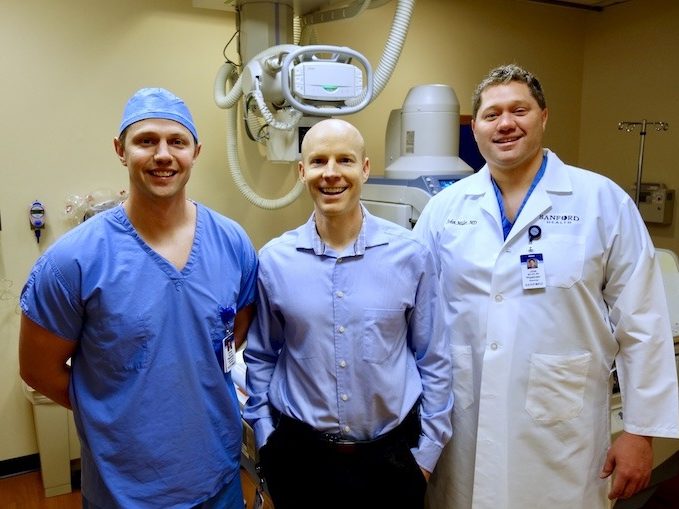Three Sanford Health physicians are collaborating with a medical imaging AI technology company to develop an artificial intelligence tool to identify cancer in radiology images of patients.
Brothers John Miller, M.D., and Andrew Miller, M.D., and fellow radiologist Joshua Rampton, M.D., practice in Bismarck, North Dakota. They worked with Sanford Health’s innovation and commercialization team to identify the collaboration partner InferVision US Inc.
It provided an image annotation and AI training computer server. The physicians pull up de-identified computerized tomography (CT) scans and circle the areas that might be cancerous. These annotated scans are what teach the AI.
The Sanford Health radiologists and InferVision’s data scientists have been collaborating to develop the cancer detecting AI model. They’re currently on the third version of the model.
“Each refined iteration has gotten better at identifying the difference between normal tissue and what is potentially cancerous,” Dr. John Miller said.
“We don’t want it calling things cancer that aren’t,” he said. “The algorithm continues to show improved pixel accuracy. If you think about a volume of data, a CT scan is slices of the patient. And each grid is a slice of pixels. A cancer takes up space in there three-dimensionally. What we’re measuring is whether we got the cancer, did we get all the pixels.”
And because the algorithm runs in the background, it could spot potentially cancerous tissue even in patients who don’t have a history of cancer.
“It’s a second pair of eyes looking for cancer in these spots that are visually difficult for the human eye to find,” Dr. John Miller said. “It makes the radiologist’s report more accurate and gives patients a clear picture of what’s happening with their disease.”
Novel approach to imaging
Braden Bills, the innovations associate on the innovation and commercialization team working on the project, said the team took a lot of precautions up front to make sure all data are secure.
“We’ve implemented a federate learning setup, where all of the scans used to train the AI are on the Sanford Health network and nothing leaves the network except the trained AI models,” he said.
“As far as the collaboration goes, the radiologists are doing the annotations and providing clinical feedback in real time. And that’s a lot of where the innovation lies, is adding value to the data sets, training the AI models, iterating and being part of the process along the whole way.”
“We get to see it happen before our eyes because we’re working hand-in-hand with InferVision,” added Dr. John Miller, who studied computer science in college. Dr. Andrew Miller got his undergraduate degree in business administration. Dr. Rampton majored in physics. All three received their medical training at the Mayo Clinic.
“The inventors’ technical backgrounds are unique among physicians and have been tremendously valuable during the development of this technology,” Bills said.
Better cancer patient care
Medical professionals strive to get it right but may be more accurate with a little help from technology, Dr. Andrew Miller said.
“That’s where the artificial intelligence comes in,” he said. “Any good idea, which I think this is, comes from recognizing a problem. As a radiologist, we’re looking at thousands of images a day. And part of our job is to look for abnormalities that can be different.”
Those differences could indicate cancer. “The goal would be to identify suspicious areas for cancer,” which may improve care through better detection of the disease, Dr. Rampton said.
That is the goal — ensuring people cared for at Sanford Health receive the most accurate diagnosis and treatment possible, which can extend or save lives and reduce health care costs.
“This is all about the patient. It helps the patient and their doctor make a more informed decision,” Dr. John Miller said.
Next steps for AI imaging
Besides helping its own patients, the technology has the potential to benefit people served by other health systems because of the partnership with InferVision.
“Being able to collaborate with Sanford Health and gain clinical insights from them is what every partner dreams of,” said Tony Gevo, VP of InferVision US Inc. “This kind of working relationship is how world-class applications are developed.”
Miller hopes it can be expanded to scan other parts of the body besides the chest.
“This is a project that has many stages,” he said. “First, can we find the cancer in the chest, and can we do it in a way that’s useful to the patient and doctor? The answer is yes. The next step is can we expand to the abdomen and neck and pelvis? We’re setting off on a journey. We’re taking our first couple of steps. Right now it seems like we’re making good progress and have a good start.”
Sanford Health is focused on innovation to bring new ideas to market that improve the health and well-being of our patients, people and communities. It values the ideas and problem-solving ability of its nurses, physicians, researchers, clinical workers and support staff. Any employee with an idea for a device, therapy, software, tool or other method that helps patients is encouraged to contact the innovations team.
Learn more
- Unique AI tool helps Sanford Health schedule nurses
- Sleep apnea AI tool uses 0s and 1s to increase ZZZs
- AI, spinoffs & new partners among Sanford Health innovations
…
Posted In Bismarck, Cancer, Cancer Screenings, Imaging, Innovations
